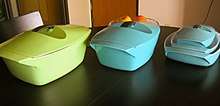Le Creuset
Le Creuset (French pronunciation: [lə kʁøze], meaning "the crucible") is a premium French cookware manufacturer best known for its colourfully-enameled cast-iron cookware "French ovens", also known as "cocottes" or "coquelles" and "sauce pans" or "casseroles" (in French). The company also makes many other types of cookware and bakeware, from fondue-sets to tagines.
| SAS | |
| Industry | Cookware |
| Founded | 1925 |
| Founder | Armand Desaegher Octave Aubecq |
| Headquarters | , |
Key people | Paul Van Zuydam (president) |
| Owner | Paul Van Zuydam |
| Website | www |

History
Le Creuset was founded in Fresnoy-le-Grand, Aisne, Picardy at the crossroads of transportation routes for iron, coke, and sand. Armand Desaegher (a Belgian casting specialist) and Octave Aubecq (a Belgian enamelling specialist) opened the foundry in 1925.[1] That same year, the first cocotte (or French oven) was produced, laying the foundation for what is now an extensive range of cookware and kitchen utensils.
The Le Creuset signature colour, Flame (orange), was used for the first piece. With their new ability to pigment the enamel glaze, Desaegher and Aubecq imitated the intense orange hue of molten cast iron in a crucible ("creuset" in French).
During World War II, Le Creuset began to focus on continually improving cast iron. In 1957, Le Creuset purchased a competitor, Les Hauts Fourneaux de Cousances, and began producing items such as a grill and a fondue set.

In the 1950s the designer Raymond Loewy introduced a futuristic type of cookware. In the 1970s Enzo Mari designed distinctive Dutch ovens and saucepans with domed lids and typical handles. In the 1980s JC Barrault's "Futura" line was launched.
In 1995, Le Creuset began exploring new product categories: stainless steel, stoneware, silicone, enamel on steel, textiles and forged hard-anodized aluminium.
The current Le Creuset logo was introduced in 1970 as a symbolic representation of metal casting and moulding.
The company was purchased by Paul Van Zuydam in 1988.[2]
Le Creuset offers a variety of colours, from bright (e.g. cherry, a gradated red) to muted (e.g. dune, a gradated off-white).[3] Its discontinued colours include cobalt (gradated blue-violet), black onyx (solid black), kiwi (gradated light green),[3] as well as slate, granite, cactus, and citron.[4][5]
Production

To manufacture their cast-iron cookware, the Le Creuset foundry uses standard sand casting methods. After hand finishing, items are sprayed with at least two coats of enamel. The enamel becomes resistant to damage during normal use. Currently, all Le Creuset cast-iron cookware is still manufactured in the company's foundry in Fresnoy-le-Grand.
Le Creuset products that are not cast-iron may be made in other countries, such as China (accessories or silicone products), Thailand (kettles and ceramics), England (enamel cleaner), Portugal (stainless steel), and Swaziland (clay pots).
References
- Guardian, David Levene for the (7 September 2015). "Le Creuset celebrates 90 years - in pictures". the Guardian. Retrieved 22 May 2016.
- "Historey". Le Creuset. Retrieved 4 October 2018.
- "True Colors". Cookware.lecreuset.com. Archived from the original on 11 April 2013. Retrieved 18 April 2014.
- "Kitchen Classic Conundrum: What Color Is Your Le Creuset?". Epicurious.com. Retrieved 18 April 2014.
- "Where can I find discontinued colors of Le Creuset? - Cookware - Chowhound". Chowhound.chow.com. 26 November 2010. Retrieved 18 April 2014.